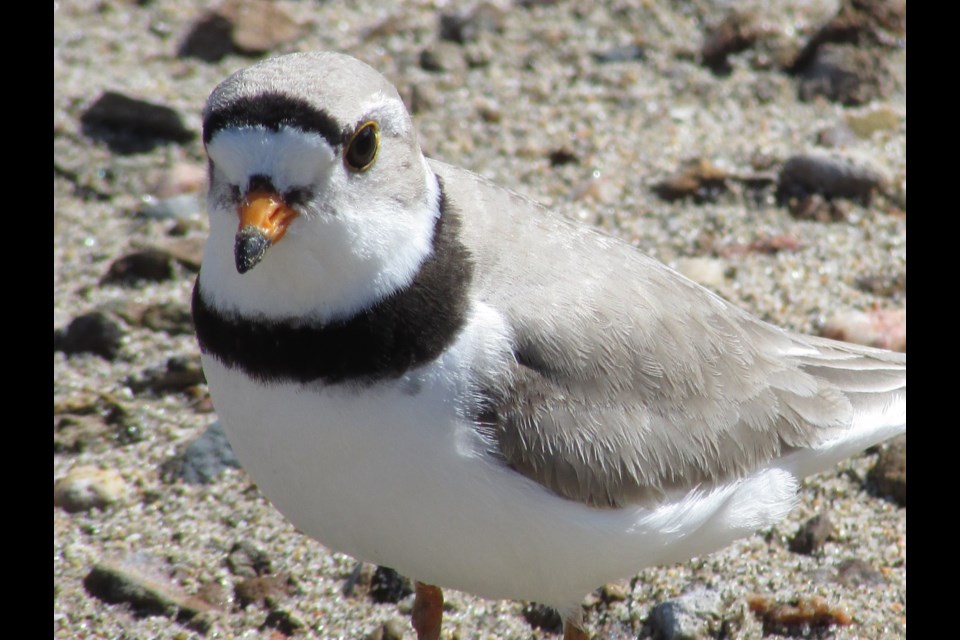REGINA – The beginning of July means the start of summer for many families, as school is out and family road trips and sunny days on the beach begin. The same can be said for Saskatchewan’s wild families.
This time of year bird species are especially active as they raise their chicks, including two bird species at risk- the Endangered Piping Plover and the Threatened Loggerhead Shrike. Nature Saskatchewan is asking families and the public to keep a watch out for these birds and report any sightings to help monitor their populations.
Along the shorelines you’ll find the Piping Plover - a small, white and tan-coloured shorebird that nests on rocky and sandy beaches below the vegetation line, and forages along the shoreline for their invertebrate prey. Their nests are shallow depressions within the sand that they line with pebbles, relying heavily on camouflage to protect the eggs from predators. Adults and chicks rely on staying still and blending in to stay safe, which makes them very difficult to spot until it’s too late. “Sandy, open beaches provide the best habitat for nesting and foraging,” explains Emily Putz, Habitat Stewardship Coordinator at Nature Saskatchewan. “Unfortunately these types of beaches are also the most attractive to humans as well for our recreation activities. We ask the public to be mindful of this as they explore Saskatchewan’s shorelines this summer.”
While most chicks have already hatched, some late nesters may still be incubating eggs. The public is asked to keep dogs on a leash and keep ATVs off the open sand in areas where plovers are known to nest in high numbers, such as Lake Diefenbaker and the shoreline of the South Saskatchewan River. Chicks will remain motionless when they sense danger, while adult plovers will perform a “broken-wing” display, as well as make vocal “peep-lo” calls, whenever their nest is approached by people or predators. If a plover is trying to lead you away from the nest, be careful of where you’re stepping!
Loggerhead Shrikes, meanwhile, can be found busy feeding their noisy chicks in thorny shrubs like buffaloberry in shelterbelts, which provide great opportunities to “impale” their prey. Also known as butcherbirds, Shrikes – which are great for pest control – are known to impale amphibians, insects like grasshoppers, and small rodents like mice on thorns, branches, or barb wire! The chicks are just beginning to explore outside of their nest in July, often following their parents to practice their hunting skills, perching on or near roadsides which are perfect places to grab insect food from. “Because of this, roadside mortality is a major threat to their population, particularly the young fledglings who are unable to fly away from an oncoming vehicle,” explains Emily Putz. “If you are hitting the roads this summer, watch for young birds on roads, particularly near shelterbelts or shrubby yard sites.” Loggerhead Shrikes are slightly smaller than a robin, and can be identified by the band of black that runs across their faces, with grey backs and wings that flash white when in flight.
Saskatchewan provides important breeding habitat for both Piping Plovers and Loggerhead Shrikes, and with the largest population of Piping Plovers in Canada, “It’s up to us to do what we can to help their chicks survive to adulthood,” concludes Putz.
Nature Saskatchewan’s voluntary stewardship programs, Shrubs for Shrikes and Plovers on Shore, work directly with land stewards to conserve habitat for species-at-risk and monitor population numbers in Saskatchewan. Sightings are recorded to help determine the distribution of these species throughout the province. This information can then be used towards efforts to conserve and restore the habitat and population of these species. Anyone can report their sightings of these species as they are out this summer enjoying Saskatchewan’s natural beauty. If you see any of these species in Saskatchewan or would like more information about our programs, please call Nature Saskatchewan’s toll-free line at 1-800-667-HOOT (4668), text (306) 780-9832, or email us at [email protected]. Private information is never shared without permission. Please also feel free to share photos, as we love to see them.



